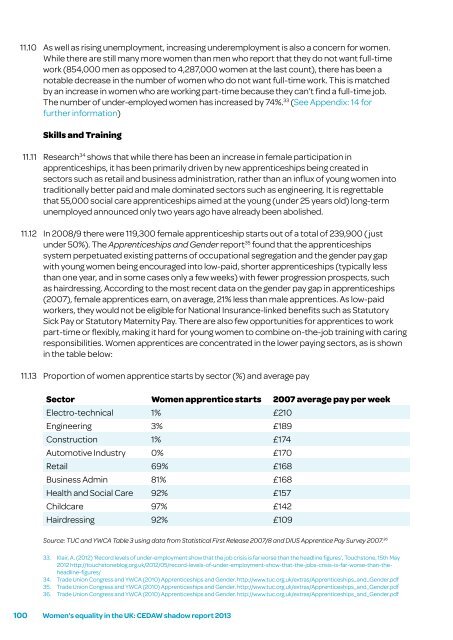Women’s equality in the UK – A health check
Women’s equality in the UK – A health check
Women’s equality in the UK – A health check
Create successful ePaper yourself
Turn your PDF publications into a flip-book with our unique Google optimized e-Paper software.
11.10<br />
11.11<br />
11.12<br />
11.13<br />
As well as ris<strong>in</strong>g unemployment, <strong>in</strong>creas<strong>in</strong>g underemployment is also a concern for women.<br />
While <strong>the</strong>re are still many more women than men who report that <strong>the</strong>y do not want full-time<br />
work (854,000 men as opposed to 4,287,000 women at <strong>the</strong> last count), <strong>the</strong>re has been a<br />
notable decrease <strong>in</strong> <strong>the</strong> number of women who do not want full-time work. This is matched<br />
by an <strong>in</strong>crease <strong>in</strong> women who are work<strong>in</strong>g part-time because <strong>the</strong>y can’t f<strong>in</strong>d a full-time job.<br />
The number of under-employed women has <strong>in</strong>creased by 74%. 33 (See Appendix: 14 for<br />
fur<strong>the</strong>r <strong>in</strong>formation)<br />
Skills and Tra<strong>in</strong><strong>in</strong>g<br />
Research 34 shows that while <strong>the</strong>re has been an <strong>in</strong>crease <strong>in</strong> female participation <strong>in</strong><br />
apprenticeships, it has been primarily driven by new apprenticeships be<strong>in</strong>g created <strong>in</strong><br />
sectors such as retail and bus<strong>in</strong>ess adm<strong>in</strong>istration, ra<strong>the</strong>r than an <strong>in</strong>flux of young women <strong>in</strong>to<br />
traditionally better paid and male dom<strong>in</strong>ated sectors such as eng<strong>in</strong>eer<strong>in</strong>g. It is regrettable<br />
that 55,000 social care apprenticeships aimed at <strong>the</strong> young (under 25 years old) long-term<br />
unemployed announced only two years ago have already been abolished.<br />
In 2008/9 <strong>the</strong>re were 119,300 female apprenticeship starts out of a total of 239,900 ( just<br />
under 50%). The Apprenticeships and Gender report 35 found that <strong>the</strong> apprenticeships<br />
system perpetuated exist<strong>in</strong>g patterns of occupational segregation and <strong>the</strong> gender pay gap<br />
with young women be<strong>in</strong>g encouraged <strong>in</strong>to low-paid, shorter apprenticeships (typically less<br />
than one year, and <strong>in</strong> some cases only a few weeks) with fewer progression prospects, such<br />
as hairdress<strong>in</strong>g. Accord<strong>in</strong>g to <strong>the</strong> most recent data on <strong>the</strong> gender pay gap <strong>in</strong> apprenticeships<br />
(2007), female apprentices earn, on average, 21% less than male apprentices. As low-paid<br />
workers, <strong>the</strong>y would not be eligible for National Insurance-l<strong>in</strong>ked benefits such as Statutory<br />
Sick Pay or Statutory Maternity Pay. There are also few opportunities for apprentices to work<br />
part-time or flexibly, mak<strong>in</strong>g it hard for young women to comb<strong>in</strong>e on-<strong>the</strong>-job tra<strong>in</strong><strong>in</strong>g with car<strong>in</strong>g<br />
responsibilities. Women apprentices are concentrated <strong>in</strong> <strong>the</strong> lower pay<strong>in</strong>g sectors, as is shown<br />
<strong>in</strong> <strong>the</strong> table below:<br />
Proportion of women apprentice starts by sector (%) and average pay<br />
Sector Women apprentice starts 2007 average pay per week<br />
Electro-technical 1% £210<br />
Eng<strong>in</strong>eer<strong>in</strong>g 3% £189<br />
Construction 1% £174<br />
Automotive Industry 0% £170<br />
Retail 69% £168<br />
Bus<strong>in</strong>ess Adm<strong>in</strong> 81% £168<br />
Health and Social Care 92% £157<br />
Childcare 97% £142<br />
Hairdress<strong>in</strong>g 92% £109<br />
Source: TUC and YWCA Table 3 us<strong>in</strong>g data from Statistical First Release 2007/8 and DIUS Apprentice Pay Survey 2007. 36<br />
33. Klair, A. (2012) ‘Record levels of under-employment show that <strong>the</strong> job crisis is far worse than <strong>the</strong> headl<strong>in</strong>e figures’, Touchstone, 15th May<br />
2012 http://touchstoneblog.org.uk/2012/05/record-levels-of-under-employment-show-that-<strong>the</strong>-jobs-crisis-is-far-worse-than-<strong>the</strong>headl<strong>in</strong>e-figures/<br />
34. Trade Union Congress and YWCA (2010) Apprenticeships and Gender. http://www.tuc.org.uk/extras/Apprenticeships_and_Gender.pdf<br />
35. Trade Union Congress and YWCA (2010) Apprenticeships and Gender. http://www.tuc.org.uk/extras/Apprenticeships_and_Gender.pdf<br />
36. Trade Union Congress and YWCA (2010) Apprenticeships and Gender. http://www.tuc.org.uk/extras/Apprenticeships_and_Gender.pdf<br />
100 <strong>Women’s</strong> <strong>equality</strong> <strong>in</strong> <strong>the</strong> <strong>UK</strong>: CEDAW shadow report 2013


